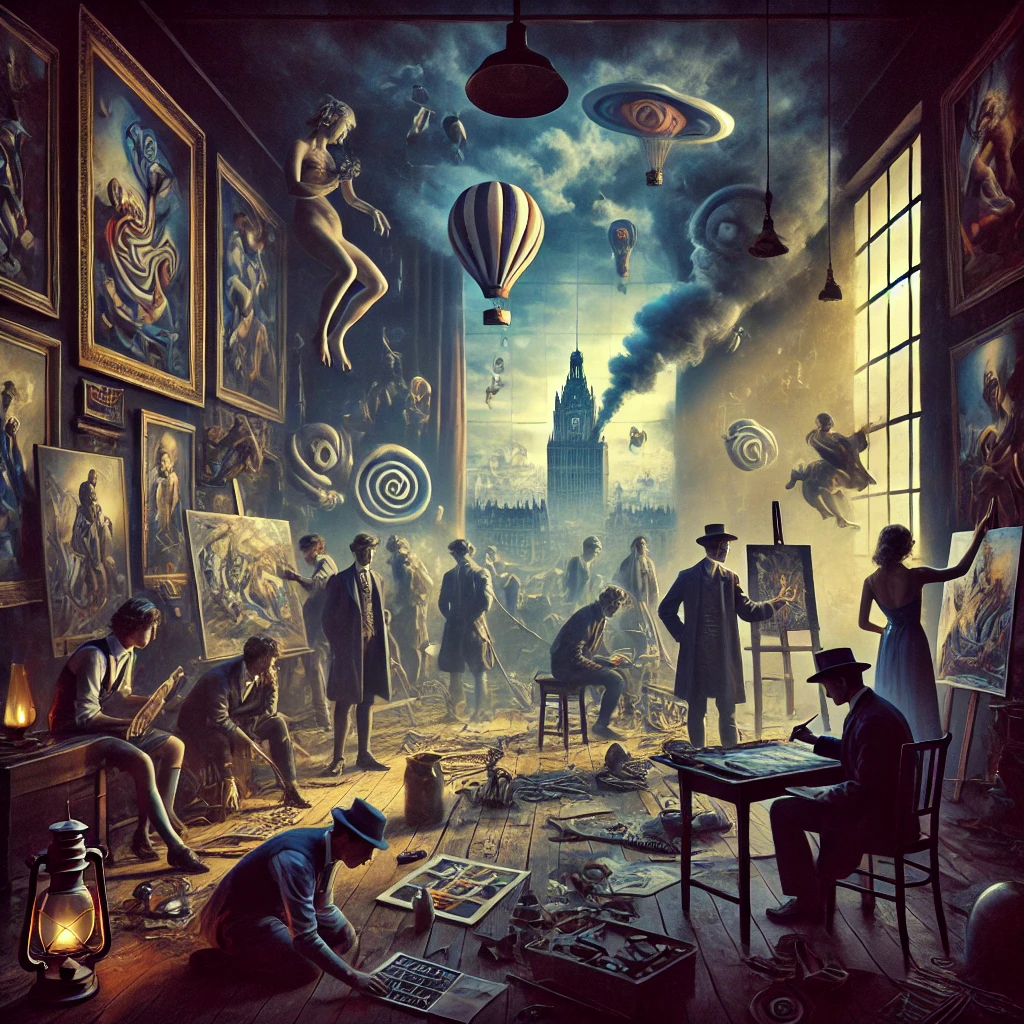
سلفادور دالي: السريالية (1904-1989)
الميلاد والحياة المبكرة
وُلِد سلفادور دومينغو فيليبي جاسينتو دالي إي دومينيك في الحادي عشر من مايو عام 1904 في فيغيراس، كاتالونيا، إسبانيا. منذ البداية، اتسمت حياة دالي بجو من الغموض والغرابة التي ستحدد شخصيته لاحقًا كواحد من أكثر الشخصيات شهرة في تاريخ الفن. لعب والداه، سلفادور دالي إي كوسي وفيليبا دومينيك فيريس، دورًا مهمًا في تشكيل تجاربه المبكرة. ترك وفاة شقيقه الأكبر، المسمى أيضًا سلفادور، قبل تسعة أشهر من ولادة دالي، انطباعًا عميقًا على الفنان، الذي اعتقد أنه تجسيد لأخيه - وهي فكرة شجعها والداه. أصبح هذا الاعتقاد بمصيره الاستثنائي موضوعًا متكررًا في حياته وعمله.

الطفولة والتأثيرات المبكرة
كانت طفولة دالي عبارة عن نسيج معقد من المشاعر والتجارب المتضاربة. كانت والدته مصدرًا للتأثير عليه، حيث شجعت مواهبه الفنية منذ سن مبكرة. وفي الوقت نفسه، كان والده منضبطًا صارمًا، حيث عزز بيئة من الدعم والتوتر في نفس الوقت. كان دالي طفلًا مبكر النضوج، حيث أظهر علامات العبقرية الفنية في وقت مبكر. بدأ الرسم عندما كان طفلاً، وبحلول سن العاشرة، كان يعرض أعماله علنًا بالفعل.
لقد كان لمناظر كاتالونيا الطبيعية، بجبالها الوعرة والبحر الأبيض المتوسط الذي لا ينقطع، تأثير كبير على رؤية دالي الفنية. فقد أشعلت تجاربه المبكرة في التعرف على أعمال الانطباعيين وما بعد الانطباعيين، بما في ذلك بيكاسو وماتيس، في متحف محلي في فيغيريس شغفه بالرسم. وقد تأثرت أعمال دالي المبكرة بشكل كبير بالانطباعية. ومع ذلك، فقد تطور أسلوبه بشكل كبير مع سعيه للتعبير عن المناظر الطبيعية السريالية في ذهنه.
التعليم والصراعات المبكرة
في عام 1922، انتقل دالي إلى مدريد للدراسة في الأكاديمية الملكية للفنون الجميلة في سان فرناندو، حيث سرعان ما أصبح شخصية محورية بين أقرانه. تميزت شخصيته المبهجة وسلوكه الغريب، وكذلك موهبته غير العادية. خلال هذه الفترة، جرب دالي أنماطًا مختلفة، بما في ذلك التكعيبية والدادائية وتقنيات الرسم الكلاسيكية. كانت مهارته الفنية لا يمكن إنكارها، ومع ذلك أدى رفضه الامتثال للمعايير الأكاديمية التقليدية إلى توترات مع مدرسيه، بلغت ذروتها بطرده من الأكاديمية في عام 1926، قبل امتحاناته النهائية.
وعلى الرغم من هذه النكسة، فقد شكلت الفترة التي قضاها دالي في مدريد مساره الفني. فقد أقام علاقات وثيقة مع نجوم المستقبل مثل المخرج السينمائي لويس بونويل والشاعر فيديريكو جارسيا لوركا. ولعبت هذه الصداقات دورًا فعالاً في تعريف دالي بالسريالية، وهي الحركة التي حددت في نهاية المطاف مسيرته المهنية. ومع ذلك، كانت علاقته بلوركا، على وجه الخصوص، محفوفة بالتعقيد، حيث تشابك التعاون الإبداعي مع التوتر العاطفي.

صعود السريالية
كانت فترة العشرينيات والثلاثينيات من القرن العشرين فترة من الاضطرابات السياسية والاجتماعية الهائلة في أوروبا. فقد تركت عواقب الحرب العالمية الأولى القارة في حالة من الاضطراب، وكان صعود الفاشية والحرب الأهلية الإسبانية مؤثرًا بشكل عميق على دالي ومعاصريه. وعلى هذه الخلفية تبنى دالي السريالية بشكل كامل. سعت هذه الحركة إلى فتح العقل اللاواعي واستكشاف الجوانب غير المنطقية والشبيهة بالأحلام في التجربة الإنسانية.
كان انضمام دالي إلى جماعة السريالية الباريسية، بقيادة أندريه بريتون، بمثابة بداية صعوده إلى الشهرة العالمية. وقد دفعته أعماله السريالية الأولى، مثل "ثبات الذاكرة" (1931)، التي تصور الساعات الذائبة الشهيرة، إلى طليعة الحركة. كانت هذه الأعمال عبارة عن تجارب فنية واستكشافات لأعمق مخاوف دالي وهواجسه ورغباته. وقد أثر افتتانه بنظريات فرويد حول التحليل النفسي والعقل اللاواعي بشكل كبير على أعماله خلال هذه الفترة.
كان لقاءه بجالا إيلوار عام 1929 من أهم نقاط التحول في حياة دالي. كانت جالا، التي ولدت باسم إيلينا إيفانوفنا دياكونوفا، مهاجرة روسية وزوجة الشاعر بول إيلوار. سرعان ما أصبحت ملهمة دالي وعشيقته وفي النهاية زوجته. كانت جالا قوة استقرار في حياة دالي المضطربة ولعبت دورًا حاسمًا في إدارة حياته المهنية، مما ساعد في ترسيخ سمعته كرائد سريالي.
عكست أعمال دالي خلال ثلاثينيات وأربعينيات القرن العشرين شغفه المتزايد بالعلم والدين والميتافيزيقيا. ويتجلى استكشافه للنظرية الذرية ومفهوم الزمان والمكان في أعماله اللاحقة، مثل "تفكك ثبات الذاكرة" (1954). وقد مثلت هذه اللوحات تحولاً من استكشافاته السريالية السابقة إلى ما أسماه "التصوف النووي"، حيث مزج الموضوعات الدينية بالاكتشافات العلمية المعاصرة.
الصداقات والصراعات
كانت علاقات دالي بالفنانين الآخرين معقدة وسريالية مثل لوحاته. كانت صداقته مع بابلو بيكاسو قائمة على الاحترام المتبادل والتنافس. وبينما كان دالي معجبًا بعبقرية بيكاسو، كان عازمًا على تجاوزه. كانت علاقتهما تتسم بالإعجاب والمنافسة، حيث كان دالي غالبًا ما يضع نفسه في موقع الخليفة الحقيقي لإرث بيكاسو.
كان ارتباط دالي بالمجموعة السريالية محفوفًا بالتوتر أيضًا. أدى تركيزه المتزايد على النجاح التجاري وآرائه السياسية، التي اعتبرت متعاطفة مع نظام فرانكو الفاشي في إسبانيا، إلى طرده في النهاية من المجموعة السريالية في عام 1939. اشتهر أندريه بريتون بتحريف اسم دالي إلى "Avida Dollars"، منتقدًا إياه لجشعه وخيانته للمبادئ السريالية. على الرغم من هذا، استمر دالي في استخدام تسمية السريالية، معلنًا، "أنا السريالية".
تطور الأسلوب والتراث
مع تقدم مسيرة دالي المهنية، أصبح عمله متنوعًا وتجريبيًا بشكل متزايد. لقد خاض تجارب في وسائل إعلام مختلفة، بما في ذلك النحت والأفلام والتصوير الفوتوغرافي والأزياء. تعاون مع ألفريد هيتشكوك في تسلسل الأحلام لفيلم "الفتاة ذات الشعر الأحمر" (1915). فيلم “سبلباوند” (1945) هو شهادة على تأثيره خارج عالم الفن التقليدي. تعكس أعمال دالي اللاحقة، مثل "الصلب (Corpus Hypercubus)" (1954)، افتتانه المستمر بتقاطع العلم والدين والفن.
إن إرث دالي متعدد الأوجه مثل أعماله. فقد كان بارعًا في الترويج لنفسه، وصياغة شخصية عامة غريبة الأطوار تطمس الخطوط الفاصلة بين الواقع والأداء. وقد جعلته شاربه الأيقوني وسلوكه المبهرج وتصريحاته الاستفزازية اسمًا مألوفًا. ومع ذلك، فقد طغت هذه الصفات أيضًا على عمق وتعقيد إنجازاته الفنية. لم يكن دالي مجرد فنان استعراضي؛ بل كان صاحب رؤية أعاد تعريف إمكانيات الفن.
كانت حياة سلفادور دالي مليئة بالإنجازات ومحاطة بالشائعات والحكايات الغامضة. وكانت عاداته الغريبة من أكثر الشائعات انتشارًا، بما في ذلك مزاعم بأنه حضر ذات مرة حفلة مرتديًا زي غواص، مع بدلة غوص وخوذة، ترمز إلى نزوله إلى العقل الباطن. كانت هذه الحيلة، مثل العديد من الحيلات الأخرى، بمثابة دليل على التزامه بالسريالية وانعكاس لنهجه الفريد في الحياة والفن.
حظيت مساهمات دالي في عالم الفن بالعديد من الأوسمة، بما في ذلك انتخابه لعضوية الأكاديمية الفرنسية للفنون الجميلة وحصوله على وسام الصليب الأعظم لوسام إيزابيلا الكاثوليكية في إسبانيا. وامتد تأثيره إلى ما هو أبعد من اللوحات، فأثر على الأدب والسينما والثقافة الشعبية.
توفي سلفادور دالي في الثالث والعشرين من يناير عام 1989 في مدينة فيغيريس مسقط رأسه، تاركًا وراءه إرثًا لا يزال يأسر ويحيّر عشاق الفن وجامعيه في جميع أنحاء العالم. ويظل عمله، الذي يتميز بإتقانه التقني وصوره السريالية ورمزيته المعقدة، حجر الزاوية في الفن الحديث. وقد ضمنت قدرة دالي على دمج الخيال مع الواقع، والعلمي مع الروحي، أن يستمر تأثيره لفترة طويلة بعد وفاته.
واليوم، تُحتفى بأعمال دالي عالميًا في المتاحف والمعارض الفنية، بدءًا من مسرح ومتحف دالي في فيغيراس وحتى متحف سلفادور دالي في سانت بطرسبرغ بولاية فلوريدا. ولا تزال لوحاته ومنحوتاته وكتاباته تلهم أجيالًا جديدة من الفنانين والمفكرين، ويطلبها بشدة جامعو الفن المميزون، مما يعزز مكانته كواحد من أكثر الشخصيات ابتكارًا وتأثيرًا في تاريخ الفن.
بينما نتأمل حياة وإرث سلفادور دالي على Exceptional.Art، ندعو عشاق الفن وجامعي التحف الفنية على حد سواء لاستكشاف المعرض عبر الإنترنت والتعمق في الإلهام الفني الذي غذى أحد أكثر العقول إثارة للاهتمام في القرن العشرين. إن رحلة دالي من بلدة صغيرة في كاتالونيا إلى قمة عالم الفن هي شهادة على قوة الإبداع والطموح والسعي الدؤوب وراء ما هو غير عادي.
إنجازات مدى الحياة وشائعات غامضة
بينما نتأمل حياة وإرث سلفادور دالي في استثنائي.فن، وجهة رئيسية لـ
معرض فني على الانترنت
و
شراء الفن عبر الإنترنت
ندعو عشاق الفن وجامعي التحف الفنية على حد سواء لاستكشاف المعرض. إن رحلة دالي من بلدة صغيرة في كاتالونيا إلى قمة عالم الفن هي شهادة على قوة الإبداع والطموح والسعي الدؤوب وراء ما هو غير عادي.
يزور استثنائي.فن لاكتشاف مجموعة مختارة من

